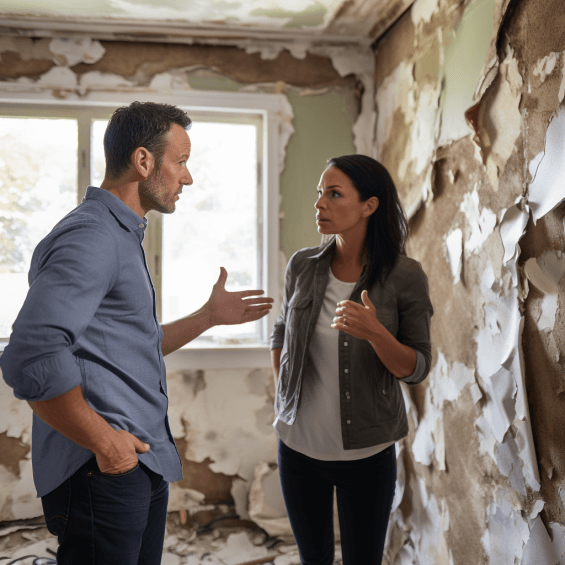
Dealing With Insurance Adjuster After Water Damage
Understanding the Extent of the Water Damage
Water damage can vary greatly in terms of severity and required repairs. It’s important to fully assess the situation to understand what needs to be done. This involves identifying the source, documenting visible damage, and checking for hidden issues.
Statistics on Household Water Leaks and Damage Costs in the US
Water leaks and resulting damage are a major problem for homeowners across America:
- Annual water losses from household leaks exceed 1 trillion gallons nationwide – equal to the annual usage of Los Angeles, Chicago, and Miami combined.
- The average home has leaks wasting over 10,000 gallons per year.
- Leaks across the US waste more than 1 trillion gallons yearly – equal to the annual usage of 11 million homes.
- Typical water damage restoration costs range from $1,300 to $5,600.
- The average insurance claim for water damage is $11,098.
- Water damage costs up to $20 billion for US homeowners annually.
- Water damage ranks as the 2nd most common home insurance claim after wind/hail damage.
These sobering statistics demonstrate the value of identifying and repairing leaks quickly.
Identifying the Source of the Leak
Pinpointing where the water is coming from is the first step. Potential sources include:
- Burst or leaking pipes
- Overflowing appliances like washing machines, dishwashers, water heaters
- Leaking sinks, showers, baths or toilets
- Roof damage or compromised flashing
- Damaged windows or improperly sealed doors
- Clogged gutters or drain pipes
- Flooding from natural disasters
If the source isn’t immediately evident, a leak detection specialist can perform tests like thermal imaging to uncover hidden leaks in walls or under floors.
Documenting Visible Damage
Once the source is found, thoroughly document any visible damage with photos/video. Key areas to check:
- Walls – look for discoloration, bulging, peeling paint or plaster
- Ceilings – signs of sagging, mold, stains
- Floors – warped or discolored boards, moisture under vinyl or tiles
- Cabinetry – swollen, delaminating materials
- Furniture – water stains, mold, warped surfaces
- Appliances – moisture behind or under large appliances
Create a detailed inventory of affected areas and property. This provides proof for insurance claims and assists with repair estimates [8].
Checking for Hidden Water Damage
Even after the leak is stopped, extensive damage may lurk out of sight inside walls, under floors, above ceilings. Signs include [9]:
- New or spreading discoloration on walls or ceilings
- Soft, spongy areas in walls, floors or carpets
- Peeling or blistering paint and wallpaper
- New or worsening mold or mildew growth
- An earthy, musty odor
- Cracked or detached flooring materials
Inspect and probe with care to determine if water has spread. Moisture meters and infrared cameras can aid in finding concealed damage.
Thoroughly identifying and documenting the type and extent of water damage provides critical information for effective emergency repairs, successful insurance claims, and safe, comprehensive restoration of the property.
Immediate Actions Upon Discovering a Leak
Discovering a water leak can be shocking. But taking quick, decisive action is crucial to stop further damage and begin the recovery process. Key steps include securing the leak’s source, assessing the scope of damage, promptly contacting your insurance provider, and bringing in water restoration specialists.
Stop the Leak if Safe to Do So
If caught early, some leaks can be halted by the homeowner. But safety comes first – don’t attempt to intervene in hazardous conditions. Potential dangers include:
- Live electrical wires in contact with water
- Rushing water that could knock you down
- Asbestos materials in older homes
- Mold or hazardous waste exposure
- Structural instability from extensive water saturation
In risky scenarios, evacuate and call emergency services. For accessible, low-risk leaks, these DIY methods may help stop the flow:
- Turn off main home water shut-off valve
- Shut off individual fixture valves (under sinks, behind toilets)
- Adjust floating ball in toilet tank
- Tighten pipe fittings and hose clamps
- Patch small holes or cracks with epoxy
- Redirect downspout extensions away from home
Once the water is off, setup fans, dehumidifiers and open windows to dry areas immediately.
Assess Extent of Damage
Evaluating damage is the next urgent step:
- Check all floors, walls, ceilings for signs of water
- Note sources/locations of visible water or moisture
- Look for hidden water in cabinets, closets, furniture
- Mark affected areas on floor plan sketch
- Take plenty of photos/video as evidence
These records help insurance adjusters determine repair costs and claim amounts.
Contact Insurance Company and Adjuster
Don’t delay reporting the claim – many policies have strict time limits. Provide your agent details including:
- Exact date/time leak began
- Suspected source
- Damage scope based on inspection
- Actions taken so far (stopping leak, cleanup efforts)
The company will assign an adjuster to visit, inspect damages, and initiate the claims process. Be ready to show documentation.
Hire Water Restoration Professionals
Experts should handle large-scale drying out and removing contaminated materials. Look for an established local firm that [14]:
- Offers 24/7 emergency response
- Uses commercial drying equipment like dehumidifiers and air scrubbers
- Has extensive water extraction experience
- Follows established industry standards and practices
- Works directly with insurance companies
Reputable companies can also detect hidden moisture and advise if mold remediation is necessary. Get a few estimates before hiring.
Taking quick, informed action minimizes the impacts of a leak. Securing the water source, assessing damage, contacting insurance providers promptly, and leveraging water restoration experts sets the stage for effectively managing the situation.
Communicating Effectively With Your Adjuster
Successfully settling your water damage claim requires clear, productive communication with your assigned adjuster. Being organized, asking key questions, and knowing what to expect in the process leads to better outcomes.
Being Prepared With Documentation
Gather and organize documentation before the adjuster arrives. Having reliable evidence readily available makes their job easier while benefiting your claim. Helpful items include:
- Photos/video capturing damage
- Written summary of damage timeline/locations
- Receipts for temporary repairs and services
- Copies of policies and previous insurer correspondence
- Inventory list of damaged/lost personal property
Presented logically in a folder or digitally, these materials strengthen your position and facilitate settlement calculations.
Asking the Right Questions
Adjusters have extensive claims experience. But this single event is new and unfamiliar to you. Don’t be afraid to ask questions:
| Topic | Potential Questions |
|---|---|
| Claim Status | – How long will the claims process take? – When can I expect settlement payment(s)? – Will you be my sole adjuster? |
| Damage Assessment | – How will hidden damage be detected? – How are repair/replacement costs calculated? – Is my assessment of the damage complete? |
| Next Steps | – What temporary repairs can I do without risking my claim? – Do I need professional restoration services? – What deadlines do I need to know? |
Adjusters appreciate homeowners who understand the procedures. Your questions help them provide answers that leave you informed and empowered.
Understanding the Claims Process
While each insurer is different, common phases after reporting your claim include:
- Investigation – Adjuster visits, inspects damage, takes measurements and photos.
- Estimate – Adjuster assesses repair/replacement costs and lost property based on investigation.
- Settlement – Insurer presents formal claim settlement outlining payment amounts.
- Repair – You hire contractors to complete repair work according to settlement terms.
- Supplemental – If additional damage is uncovered during repairs, submit documentation for amended claim.
- Closure – Claim ends upon completion and inspection of repair work.
Adjusters can clarify how this maps to your unique claim. But understanding the road ahead provides reassurance and perspective.
Being proactive in your communications with insurance adjusters through thorough documentation, targeted questions, and grasping the full claims process leads to satisfactory outcomes for all parties after water damage.
Preserving Evidence and Documentation
Properly documenting water damage is crucial for insurance claims, repairs, and preventing future issues. Photographic and written records, along with saving receipts, provides proof for adjusters and contractors.
Photos and Video of Damage
Visual documentation offers definitive evidence of damage incurred. Be systematic and thorough:
- Capture overall views of affected rooms before focusing in
- Take photos from multiple angles to show context
- Zoom in on specific affected areas and property
- Return over several days to document changing conditions
- Include a point of reference for scale (ruler, person)
- Note date/time and location details on each image
Both still photos and video walkthroughs are effective. Store digitally in cloud folders for easy access and sharing.
Receipts for Emergency Work
After stopping the water source, essential next steps are minimizing further damage and health hazards. Save receipts for expenses like:
- Equipment rental (dehumidifiers, generators, fans)
- Water extraction supplies (pumps, hoses, squeegees)
- Temporary safety solutions (tarps, sandbags, plywood)
- Accommodations if displaced from home
- Initial mold remediation if present
Submit copies to your adjuster annotated with details on purpose and location. These costs may provide reimbursement beyond the final property settlement.
“Keep in mind that the faster you act to dry out affected areas, the more your chances improve for restoring versus fully replacing damaged materials.” – Ed Smith, impairment specialist
Written Correspondence and Agreements With Adjuster
All communication with your insurance adjuster provides legal record if questions arise later. Save copies of:
- Emails and letters with your adjuster
- Claim paperwork and supplements they provide
- Any written estimates or approvals from your adjuster
- Notes from phone conversations (date, time, summary)
- Contracts or work orders from restoration contractors
Having a paper trail proves helpful if:
- You need to request an extension or supplemental claim during repairs
- An assigned adjuster changes mid-process
- Any disputes over settlement amounts or coverage arise
Thoroughly documenting damage through photos/video, keeping receipts for emergency work, and maintaining written communication ensures you can effectively work with adjusters while protecting your property interests.
Negotiating Your Settlement
Getting proper reimbursement for water damage relies on effectively negotiating your insurance claim settlement. Understanding average payouts, getting repair estimates, and collaborating with adjusters leads to favorable outcomes.
Average Water Damage Claim Amounts
Insurance claim data provides useful context on typical settlement ranges:
- The average claim for water damage is $11,098.
- Minor damage claims often fall between $3,000 – $8,000.
- Major damage claims commonly range from $15,000 – $30,000.
- Severe cases with extensive replacement needs may exceed $50,000.
While your specific claim depends on many factors, these averages help set reasonable expectations.
Replacement Cost Factors
Insurance settlements are usually first framed around actual cash value (ACV), which accounts for depreciation. But water damage often requires full replacement using replacement cost value (RCV). Get familiar with RCV calculation factors:
- Material costs are based on current prices for equivalent construction materials.
- Labor costs reflect hourly rates for required trades (carpenters, plumbers, electricians).
- Overhead and profit margins are added by contractors as typical for your region.
- Code upgrades may be mandated to meet changed regulations.
- Contingencies account for undiscovered damage that may emerge.
Your contractor estimates should reflect up-to-date RCV pricing.
Meeting With Contractors for Repair Estimates
Do not rely solely on your adjuster’s assessment. Independent contractor estimates better reflect true repair/replacement costs. Look for contractors who:
- Provide line-item estimates listing materials, labor, margins
- Use current industry standard pricing tools like Xactimate
- Specialize in your type of water damage
- Have strong local references
Meeting with multiple contractors offers useful comparisons and average pricing insights.
Working With Your Adjuster to Align on Final Settlement
Ideally, your adjuster’s initial settlement offer will be adequate. If not, discuss gaps using contractor estimates for support. Focus negotiations on:
- Ensuring your preferred contractors and costs are represented
- Noting any missing damaged items that still require addressing
- Identifying any contingency padding needed for undiscovered issues
By collaborating with your adjuster armed with thorough contractor estimates reflecting full replacement cost value, you increase the likelihood of securing a fair settlement.
Completing Repairs and Finalizing the Claim
Once your insurance settlement is secured, diligently completing repairs while observing claim requirements allows you to fully restore from the water damage.
Hiring Qualified Professionals for Restoration
Don’t cut corners when hiring contractors – poor workmanship can exacerbate lingering issues. Seek those who:
- Have specific water damage repair expertise
- Offer long-term warranties on workmanship
- Use drying equipment that complies with ANSI standards
- Are properly licensed, bonded, and insured
- Follow established protocols for containing construction dust/debris
Check references from local customers, review sample contracts thoroughly, and verify necessary licenses. Investing in quality contractors leads to lasting repairs.
“I cannot stress enough: take your time and really vet anyone you let into your home for major restoration work after water damage. The lowest bid should not be your key driver.” – Amanda James, restoration project manager
Providing Payment Proof to Insurance Company
Most insurers issue initial claim payments based on actual cash value, withholding depreciation until repairs are completed. To recover depreciation:
- Make copies of all repair invoices and payment receipts
- Highlight materials, services, and payments matching claim line items
- Submit documentation to your adjuster with a request to release depreciation
- Expect an inspection before final payment to verify work
Thorough records prove you completed agreed repairs so remaining funds get disbursed.
Following Up on Any Additional Costs
Despite best efforts, unforeseen issues inevitably emerge during restoration work:
- Water penetrated further than originally detected
- Mold spread behind walls needing remediation
- Code updates are triggered by repairs
- Damaged items are uncovered once content drying finishes
If significant new costs surface, submit a supplemental claim with supporting documentation. Small marginal overages should have contingency funds from your original claim available. But be proactive in reporting legitimate expenses exceeding the claim’s scope.
By hiring reputable contractors, providing payment documentation, and requesting any supplemental funds needed, you successfully complete repairs and close out your water damage insurance claim.
Preventing Common Mistakes
When under stress after water damage, homeowners can make unnecessary errors. Avoid these common pitfalls:
###Not Disposing of or Repairing Damaged Items Prematurely
In the rush to recover, it’s tempting to throw away damaged property or attempt repairs. But this jeopardizes your settlement, so first:
- Consult your adjuster about any items declared a total loss
- Let a restoration professional handle attempting repairs
- If discarded, prove discarded items’ worth with photos, receipts
Making irreversible choices without approval may lower your claim value.
Not Getting Adjuster Approval Before Repairs
Although eager to restore your home, significant repairs impact your claim. Always discuss with your adjuster:
- The repair plan and scope of work
- Contractor bids and estimates
- Any concerns about coverage or costs
Starting work without approval may lead the insurer to deny claim expansion requests.
Relying Only on Initial Damage Assessment
Even very thorough early inspections miss hidden issues like:
- Mold growing inside walls
- Warped floor joists underneath subflooring
- Absorbed moisture under floor treatments
Expect discoveries during demolition requiring supplemental claims. Don’t presume the initial assessment is comprehensive.
Mistakes from impatience and assumptions can complicate insurance settlements – work with your adjuster to prevent common water damage pitfalls.
Preventing Future Water Damage
Restoring after water damage provides opportunity to upgrade home systems and prevent recurrence.
Investing in Leak Detection Systems
Installed sensors can discover plumbing leaks early before major damage results:
- Wireless sensors detect moisture along floor perimeters.
- Flow meters reveal unusual water usage patterns.
- Automatic water shut-off valves activate when leaks occur.
Combined with monitoring services, these technologies offer peace of mind and protection.
Maintaining Your Home’s Plumbing
Many leaks arise from aging pipes and fittings. Help avoid them by:
- Annually inspecting visible plumbing for drips or corrosion.
- Replacing brass fittings and valves every 10-15 years.
- Updating steel/cast iron supply lines to copper.
- Repiping entirely with PEX or PVC.
- Relining pipes with epoxy coatings.
Proactive maintenance reduces failure risks.
Making Necessary Roof Repairs
Roof leaks are a major contributor to water damage. Optimize roof condition by:
- Performing a professional roof inspection annually.
- Checking flashings around vents, skylights, chimneys.
- Clearing gutters and downspouts regularly.
- Resealing any asphalt shingles showing curling or loss of adhesion.
- Identifying any sagging or warped wood shake areas.
Effectively managing roof issues provides vital protection.
A bit of prevention goes a long way – strategic upgrades and proactive maintenance safeguard against recurring, costly water damage.
When to Consider Legal Help
Pursing legal options against insurers should be a last resort option. But in limited cases, an attorney may help resolve claim disputes.
Denied Claims
If your claim gets denied, consider legal assistance to appeal if:
- Denial letters lack required details on reasons.
- The policy language is ambiguous on your specific type of loss.
- Your situation reasonably meets the policy’s covered criteria.
An attorney can evaluate denial validity and counsel on next steps.
“In my experience,Claims Leakage Insurers frequently deny claims just hoping policyholders will give up – but a quick consultation with a lawyer can clarify if you have grounds to keep pushing the issue.” – Ryan Patterson, insurance lawyer
Disputes Over Settlement Amounts
If multiple contractors confirm your insurer’s settlement offer is inadequate, an attorney may aid negotiations by:
- Demanding justification for low estimates
- Citing regulations requiring reasonable settlements
- Pursuing mediation if needed
Sometimes legal leverage is needed to reach an acceptable claims amount.
Suspected Bad Faith Practices
If you reasonably believe unfair practices are occurring such as:
- Repeated, unjustified delays
- Misrepresented policy terms
- Intentionally deficient investigation
then documenting and pursuing action for bad faith may be warranted. An attorney can advise on building a case and next steps if you have valid concerns.
In most water damage claim scenarios, keeping an open dialog with your adjuster should resolve any issues. But for denials, severe underpayment, or suspected unethical behavior, discussing options with an attorney could help get you fair insurance compensation.






